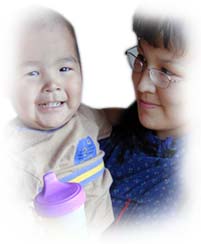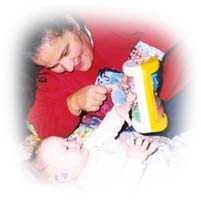Universal Newborn Hearing Screening
Frequently Ask Questions for Parents
Please choose from the questions below for more information about Universal Newborn Hearing Screening / Early Hearing Detection & Intervention
What is it?
It is a screening test to check if your baby's hearing is normal at birth or if more testing is needed.
When is it done?
It is important to check your baby's hearing in the newborn nursery prior to hospital discharge. If your birthing facility does not offer the screening, ask to be referred to a facility that does and have it performed before your baby is one month of age.
How is it done?
 This screening is not painful in any way to your baby. There are two pieces of equipment used to screen babies hearing, Otoacoustic Emissions (OAE) and Auditory Brainstem Response (AABR). With the AABR, three tiny sensors are placed on your baby’s head using a jelly-like substance.
This screening is not painful in any way to your baby. There are two pieces of equipment used to screen babies hearing, Otoacoustic Emissions (OAE) and Auditory Brainstem Response (AABR). With the AABR, three tiny sensors are placed on your baby’s head using a jelly-like substance.
The machine makes a soft clicking sound. As your baby listens to the sounds through the ear cups, the sensors record and measure how your baby’s brain responds to the clicks. With the OAE, a soft probe is placed into the ear canals. Soft sounds are played into the ear and when the ear is working normally, thousands of invisible hair cells in the ear move in response to the incoming sound. When the hairs move, they make sounds of their own which leak back out through the ear and are measured by a sensitive microphone located in the probe. When hearing loss exists, the hair cells are damaged and do not emit a sound.
Why is it important?
Hearing loss is the most common birth disorder in newborns. About three out of every 1,000 babies are born with some type of hearing loss. Before newborn hearing screening, the average age of detection of hearing loss was between two and three years of age. Hearing loss that goes untreated may lead to speech and language delays, as well as delays in school. However, delays may be lessened or avoided if a hearing loss is discovered early, before three months of age, and the infant receives treatment through early intervention.
What causes hearing loss in newborns?
There are many causes of hearing loss in newborns. Some may be temporary and easily corrected. For example, a blockage of the ear canal, or fluid in the middle ear may cause a hearing loss. Some hearing loss is permanent and may only be corrected by hearing aids or other listening devices. Some infections that mothers may have during pregnancy, such as Rubella, may cause an infant’s hearing loss at birth. Hearing loss may also be passed on in families. Sometimes there is no known cause for hearing loss in newborns. For a list of known causes of hearing loss in newborns, please see this  table developed by the Joint Committee on Infant Hearing.
table developed by the Joint Committee on Infant Hearing.
What does it mean if my baby does not pass their newborn hearning screening?
 It does not mean that your baby cannot hear. It only means that your baby needs to be screened again while in the newborn nursery. If your baby does not pass the second, or if necessary, third screen, he/she will need to see a hearing specialist (audiologist) for further tests. The audiologist will do special tests to find out for sure if there is a hearing loss, and if so, what kind of hearing loss it is. The audiologist will also evaluate how loud different sounds need to be in order for your baby to hear them. Your baby should see a pediatric audiologist, someone that specializes in children’s hearing loss, before three months of age.
It does not mean that your baby cannot hear. It only means that your baby needs to be screened again while in the newborn nursery. If your baby does not pass the second, or if necessary, third screen, he/she will need to see a hearing specialist (audiologist) for further tests. The audiologist will do special tests to find out for sure if there is a hearing loss, and if so, what kind of hearing loss it is. The audiologist will also evaluate how loud different sounds need to be in order for your baby to hear them. Your baby should see a pediatric audiologist, someone that specializes in children’s hearing loss, before three months of age.
It is important to note that some babies do not have hearing loss at birth, but may develop hearing loss later in life. If a hearing loss is suspected at any time, please contact your health care provider. To determine if your child may not be hearing properly, please refer to the speech and hearing developmental milestone checklist.
What do I do if my baby does not pass the hearing test with the audiologist?
There is a special program for families of infants and toddlers, birth to three years of age, who have special needs, including hearing loss. This program is called the Early Intervention/Infant Learning Program (EI/ILP) and is available through the State of Alaska, Dept. of Health and Social Services. For more information, visit the Infant Learning Program website.
What information is available about newborn hearing screening?
Alaska’s Early Hearing Detection & Intervention (EHDI) Program has developed the following information for parents and the general public. To receive hard copies of the material(s), please contact us, or fax us an order form.
In an effort to promote public awareness regarding UNHS, a four-pronged approach covering all steps involved in the diagnosis of a possible hearing loss, was developed and outlined below:
Alaska’s Universal Newborn Hearing Screening (UNHS) general brochure

includes basic information about newborn hearing screening, including information about what the screening is and why it is being done, and strives to represent all Alaskans by including photos of children from various ethnic backgrounds.
The brochure is intended for pregnant mothers, those women that have just given birth, and the general public. Ideal locations for delivery of the brochure include, but are not limited to, childbirth and prenatal classes, ob/gyns offices, mother baby units, and birthing centers.
“What’s the Next Step?” brochure
includes information about who parents should contact in their community for further testing regarding a suspected hearing loss and why this is important in terms of reducing or minimizing developmental delays. “What’s the Next Step?” is intended for parents of newborns who refer, or do not pass, the hearing screening in the nursery. It will be available for nurses, audiologists, and other health care providers who work with children and hearing loss, to deliver to parents as needed.
Communicate with Your Child brochure
was developed in a format easy for parents to read and locate information about what should be done after a hearing loss is detected, including who to contact, and other basics regarding how best for parents to help an infant/child with hearing loss communicate.
Alaska’s Early Hearing Detection & Intervention (EHDI) parent resource manual
is in a format easy for parents to read and divided into sections to make it simple to locate information including introductions, frequently asked questions, checklists, resources, and terminology. Included in the manual are topics including information regarding hearing loss, tests, early intervention, advocacy, communication options, and educational options.
